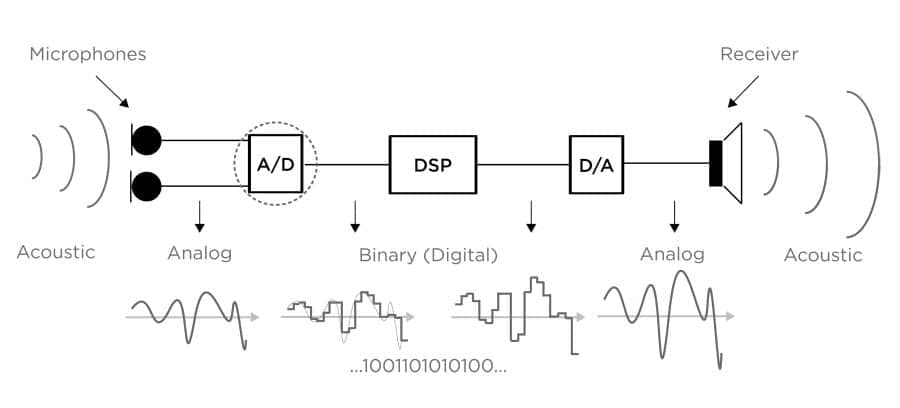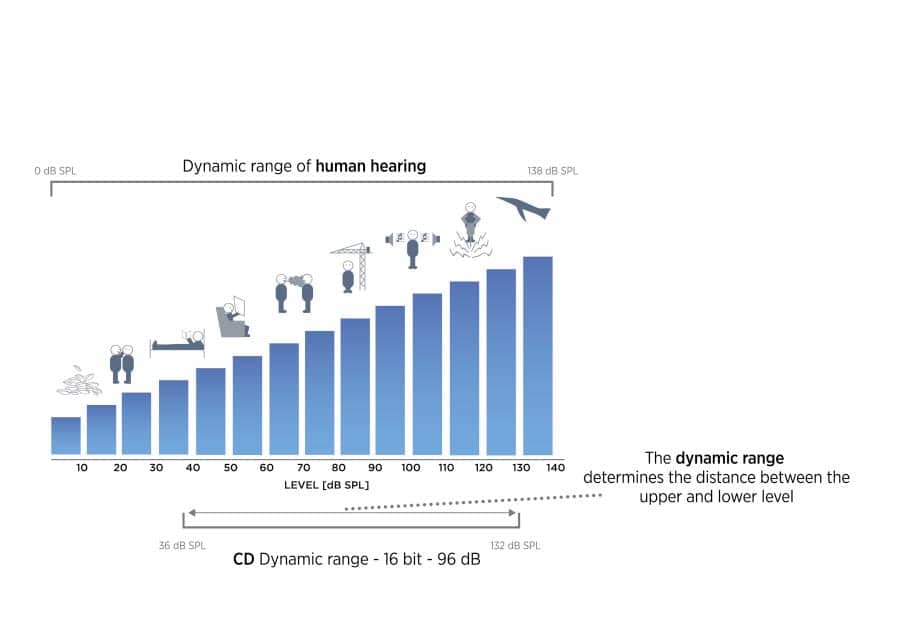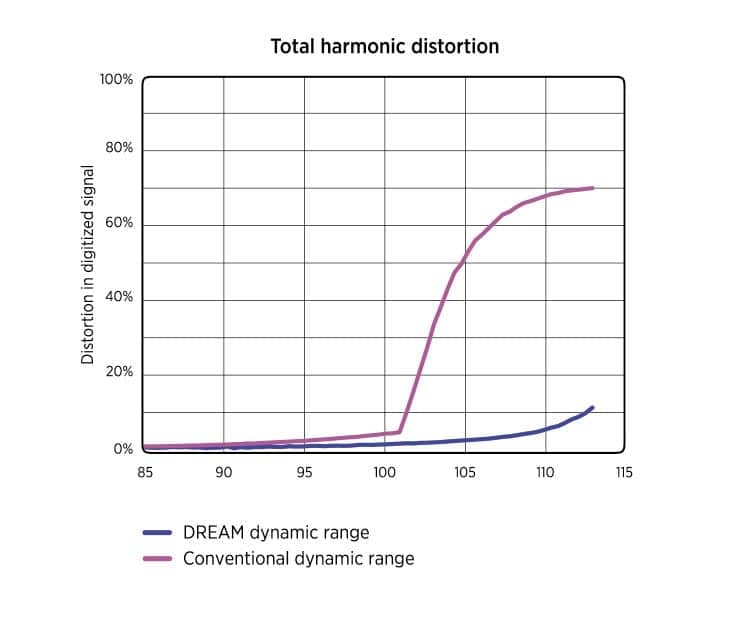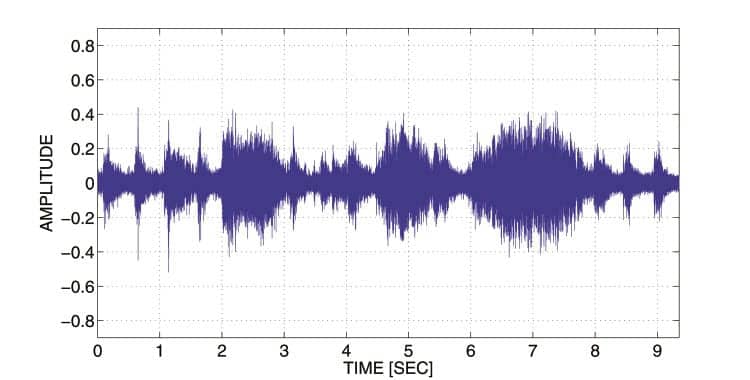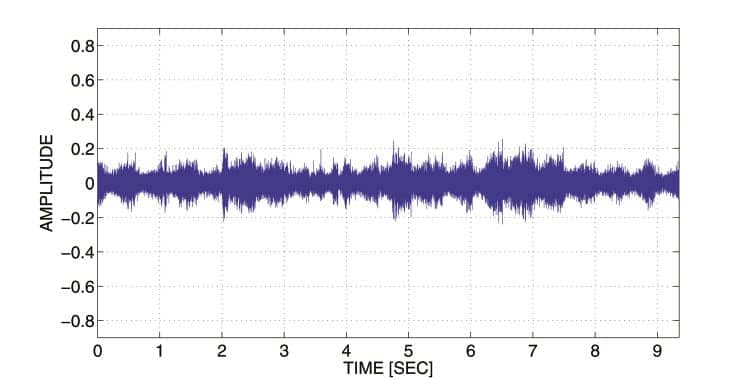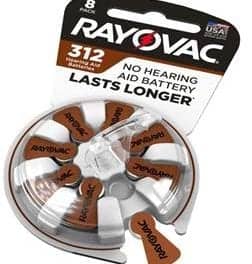By Lars Baekgaard, MSc; Niels Ole Knudsen; Tayyib Arshad, MSc; and Hanne Pernille Andersen, PhD
The A/D converter has been an Achilles’ heel in hearing aid design. Here’s why, as well as details about a new hearing aid that has tackled this problem.
Ever since the introduction of fully digital hearing aids in the mid-1990s, the development of advanced digital features has been given a relatively large amount of attention by the hearing aid industry. A vast array of sophisticated digital features—including adaptive directional microphone systems, feedback cancelation, noise suppression, and frequency shifting—are available in today’s hearing aids.
However, for the user to derive full benefit from the advanced processing and features of modern digital hearing aids, basic design parameters such as sampling rate and bit resolution have to be sufficiently optimized to allow a faithful, artifact-free sound reproduction. In addition, digital signal processing (DSP) requires signals to be converted from analog to digital and back again by means of A/D and D/A converters. This process, if not carefully designed, can introduce noise and distortion, which will ultimately compromise the performance of the hearing aids (Figure 1).
One parameter that impacts the sound quality in a digital hearing aid is the sampling rate—or the number of times the analog signal is sampled each second. The sampling rate determines the range of frequencies that can be represented in the digital signal. A faithful, artifact-free representation of an analog signal requires a sampling rate that is at least twice the highest frequency contained in the signal. This is known as the Nyquist Sampling Theorem. Thus, for example, in order to reproduce frequencies of up to 10 kHz, the sampling rate must be 20 kHz or higher. Otherwise, an audible error known as aliasing will be introduced into the signal.
Another parameter that affects the sound quality of a digital hearing aid is the bit depth—or the number of bits used to store information about each sample. A sufficient number of bits must be available to represent both the largest and the smallest signals. If too few bits are available to represent the signal, it leads to quantization errors—imprecision in the representation of the signal in the case of low signal levels, and distortion (clipping) with high signal levels.
Nowadays, these design parameters have been optimized sufficiently in most high-end hearing aids to permit an accurate digital representation of the signal in the DSP without the occurrence of artifacts such as aliasing and quantization errors. But there is still at least one major processing problem…
The A/D Converter: The Achilles’ Heel of Modern Digital Hearing Aids
The human ear is capable of hearing sounds within the range of approximately 0 to 138 dB SPL. In other words, the dynamic range of human hearing is about 138 dB. Ideally, therefore, a hearing aid should be able to reproduce sounds at all levels within this range.
In reality, however, state-of-the-art digital hearing aids typically use a 16-bit A/D converter, which corresponds to a dynamic range of 96 dB—the same as that of, for example, a CD. The dynamic range of a CD covers levels from only 36 dB to 132 dB SPL, which is a limited part of the range that the human ear is capable of perceiving. Yet, most people nevertheless perceive the sound quality of a CD to be excellent.
Thus, providing high sound quality in a hearing aid does not necessarily require the reproduction of the entire human dynamic range. What matters is where the upper limit (also referred to as the input range) and the lower limit of the dynamic range are located. Essentially, the lower the upper limit, the poorer the sound quality. If the lower limit is raised too much, it will result in reduced access to soft sounds for the hearing aid user, as sounds below the lower limit will not be processed by the hearing aid (Figure 2).
The Problem of Loud Input Levels
Historically, most hearing aid manufacturers have chosen to implement the dynamic range of the A/D converter in 16-bit hearing aids in the vicinity of 0-96 dB SPL.1,2 This is because, even if you shout, the loudest speech components will usually be within 85-90 dB SPL. However, even though all levels of speech may be covered by a 0-96 dB dynamic range, other types of input are much more intense. Medium-to-loud volume music may, for example, easily exceed 100 dB SPL.1-3
If the input signal is so loud that it exceeds the A/D converter’s input range (ie, its upper limit), the A/D converter overloads, resulting in highly perceptible distortion (clipping) that is typically perceived by hearing aid users as a “crackling” or “raspy” sound quality. And once the signal has been distorted, it is impossible to improve the sound quality at a later stage in the signal processing. Front-end distortion must therefore be prevented from occurring in the first place at loud input levels, if high sound quality is to be maintained (Figure 3).
| Figure 3. If the original signal (left) exceeds the maximum level that the A/D converter is capable of handling, a part of the original signal will be missing when the signal is digitized (right). This form of distortion, known as clipping, is typically perceived as a “crackling” or “raspy” sound quality by hearing aid users. |
The problem of clipping distortion is not restricted to loud music. It can occur in any situation with loud sound levels, such as a busy restaurant where speech is produced in the presence of loud noise. In such a situation, clipping will affect both the speech signal and the noise signal, because the front end of the hearing aid is unable to distinguish between wanted and unwanted signals.
More specifically, when a speech signal and a loud noise signal are picked up by the hearing aid microphone, they are merged into a single signal that is processed in unison during the digitization (Figure 4). If the level of the unified signal exceeds the upper limit of the A/D converter, with resultant clipping, both the speech and the noise signal may be corrupted, as the system does not distinguish between speech and noise at this stage (the speech-vs-noise analysis used by the noise reduction features is conducted after the signal has been digitized).
These errors introduced into the unified signal cannot be fixed at a later stage. They will be carried through every stage of the signal processing. Consequently, when the hearing aid’s output signal is eventually played into the user’s ear—and the user’s brain attempts to split it up into a speech and a noise signal—both the original speech and the noise signal will be reproduced inaccurately, resulting in perceptibly poor sound quality.
Current Methods of Eliminating Front-end Distortion
Several techniques are currently employed to minimize front-end distortion in hearing aids. These essentially fall into two categories:
1) Reducing the level of intensity of the input signal. This can be achieved by either: a) decreasing the sensitivity of the microphone, or b) introducing automatic gain compression at the input (AGCi, also known as input compression).
Reduced microphone sensitivity can, for example, be achieved by using a microphone with reduced sensitivity in the low frequencies. The benefit of using such a microphone is that intense low-frequency sounds will mainly enter the ear canal directly through the vent, or an open fitting. Because of the reduced low-frequency sensitivity of the microphone, these sounds will be significantly attenuated when entering the hearing aid, which in turn will minimize the risk of distortion. However, as pointed out by Chasin,4-6 the greatest disadvantage of this solution is that it is mainly applicable to clients with a mild degree of hearing loss in the low frequencies for whom the low-frequency gain and output requirements would be relatively modest, and who would typically be fitted with a non-occluding earmold.
The intensity level of the input signal also can be reduced by placing an electronic network immediately after the hearing aid microphones, which applies a uniform reduction of, for instance, 10 to 12 dB.3 A third, very simple and inexpensive way to reduce the intensity level of the signal by 5-10 dB is simply to tape over the hearing aid microphone(s) with a piece of Scotch tape.3,4
Regardless of the specific approach taken, a universal drawback of reducing the intensity level at the microphone is that, while the intensity of the input signal will be reduced, the internal noise of the microphone will remain the same. This leads to a poorer signal-to-noise ratio (SNR).
Input compression (AGCi) is a well-known approach to minimizing front-end distortion in the hearing aid industry. By dynamically adjusting the pre-amplifier’s gain, an AGCi continuously compresses the input signal according to the current input level, thereby keeping the signal below the distortion limit of the A/D converter.
However, a major drawback of AGCi is that, although it eliminates clipping artifacts, it also can introduce dynamic artifacts instead—including the smearing of intensity cues,7 a “pumping” sound, or a reduction in the richness of the sound signal. In real life, this might mean that a hearing aid user attending a classical music concert would experience rapid changes in the loudness level of some instruments during music passages in which other instruments blend in at intervals. The effect is similar to constantly turning up and down the volume on your hi-fi in order to adjust for the momentary loudness of the music playing, resulting in a “muffled” or “dull” sound quality due to a reduction in the dynamics of the original signal. This might mean that a hearing aid user listening to a radio program could perceive the speaker’s voice to have a “dull” quality because some of the richness of the sound is missing. Or, for a hearing aid user attending a sports event, the whole atmosphere at the stadium may feel much less exciting because the cheering and clapping of the spectators sounds “muffled” or “distant.”
2) Increasing the headroom by shifting the operating range of the A/D converter upwards. An alternative approach to minimizing distortion in the A/D converter is to increase the headroom (ie, the gap between the input signal and the system limit above which the signal will be distorted) by shifting the operating range of the A/D converter upwards.
As mentioned above, there is no inherent reason why the operating range of modern 16-bit hearing aids should necessarily extend from approximately 0 to 96 dB SPL. The upper and lower limits of the operating range might as well lie at, say, 116 dB and 20 dB SPL, respectively. This would mean that very soft sounds below 20 dB SPL would not be processed by the hearing aid; however, because the microphones themselves generate an internal noise floor of approximately 20 dB SPL, in which very soft sounds are drowned out, this has no practical, discernible consequences.
Unlike the Maximum Power Output (MPO) of a hearing aid, the headroom of an A/D converter is not adjustable. Instead, the A/D converter has a physical constraint that defines a fixed input range. To increase the headroom (ie, the input range), a redesign of the physical chip is therefore required. A redesign is expensive in terms of both time and money, and must be done carefully in order to precisely match the other stages in the hearing aid processing. This may be one of the key reasons why this method is not currently widely applied in hearing devices.
The perceptual consequences of two of the most widely used strategies, namely, peak clipping and compression limiting, have been investigated in several studies.8-11 The results of this research suggest that, where objectively measured speech perception is concerned, compression limiting may have a slight advantage over peak clipping for subjects with mild-to-moderate hearing loss, but not for subjects with severe-to-profound hearing loss.9,10 However, when it comes to subjectively perceived sound quality, both strategies have been found to have a relatively strong detrimental effect,11,12 suggesting that it is best to avoid peak clipping and compression limiting strategies if one’s design goals include the preservation of sound quality at high input levels.
This prompted Widex to search for new ways to ensure that louder signal levels could pass through the A/D converter without introducing distortion products. The result is a new A/D converter with an upper limit of 113 dB SPL. The new converter will be described in detail below.
Provide High-fidelity Sound at All Input Levels
Until now, attempts to upwardly shift the operating range of the A/D converter to above 110 dB SPL have been restricted to a dedicated music program produced by one manufacturer, and a specialized product developed specifically for musicians.3 As far as can be determined, the new Widex DREAM hearing aid family (introduced in 2013) is the first to offer an upper limit of 113 dB SPL universally in a hearing aid designed for general use.
The Widex DREAM is a new, wireless, advanced-technology hearing aid family designed to provide high-fidelity sound reproduction. In addition to an array of sophisticated digital signal processing features, great efforts have been made to ensure that the Widex DREAM family also offers optimal design parameters for a faithful reproduction of the original sound. These include a bandwidth of up to 10.5 kHz, a sampling rate of 33.1 kHz, and a new improved 16-bit A/D converter design.
With a dynamic range stretching from 17 to 113 dB SPL—rather than under 10 dB to less than 110 dB SPL in older generations of converters—the new A/D converter has been designed to handle all signal levels optimally, including very loud signal levels. Shifting the dynamic range in the A/D converter upwards to this range means that more loud input is allowed to pass through undistorted, while the audibility of soft sounds is still preserved.
Figure 6 shows the effect of shifting the dynamic range on the digitized signal. This demonstrates the amount of distortion in the digitized signal with an older generation A/D converter versus with the A/D converter in the Widex DREAM hearing aid family at loud input levels. There is a dramatic increase in distortion at one point with the older generation A/D converter, whereas distortion remains low throughout with the Widex DREAM A/D converter.
The advantages of shifting the operating range of the A/D converter, compared to other well-known current strategies, are further illustrated in Figure 7. This example shows the output of a DREAM hearing aid and two recent high-end wireless hearing aids, one of which has an A/D converter with a “conventional” dynamic range of under 10 dB to less than 110 dB SPL, while the other employs input compression. The input signal consists of loud cheering during a sports game. The hearing aids were fitted to a flat hearing loss of 25 dB HL in the default listening program using the manufacturer’s default settings. Compared to the DREAM hearing aid, the output of the hearing aid with the older-generation A/D converter is characterized by peak clipping, while the output of the hearing aid that employs input compression has been “squeezed.”
Potential Benefits of Shifting the A/D Converter’s Dynamic Range Upwards
The increased headroom of the A/D converter in the Widex DREAM hearing aid can be expected to generate benefits for the hearing aid user in a number of different real-life situations with loud inputs.
Music. As mentioned above, the hearing aid industry has been concentrating its efforts on improving the perception of speech in different environments, while other inputs, such as music, have been a secondary consideration. Because hearing aids are designed with a focus on speech perception, hearing-impaired concert-goers and musicians often complain about the sound quality of live music, which is typically distorted when reproduced by a hearing aid. The increased headroom in the DREAM A/D converter has the potential to improve the musical experience for musicians and music lovers. As higher input levels are allowed before clipping occurs, distortion of the music signal is reduced significantly, which in turn means that the quality of the music when reproduced by the hearing aid is greatly improved.
Speech perception in loud noise. The distortion that may occur at high input levels in hearing aids with an older generation A/D converter also can have repercussions in situations in which the hearing aid user is attempting to hear speech produced in a situation of loud background noise (eg, busy restaurant). As previously discussed, the signal processing in a hearing aid requires a linear relationship between input and output at each stage to function optimally. If clipping occurs, the output signal of the A/D converter will not match the input signal, and this degeneration of the original signal will carry through all the subsequent stages and will be clearly audible in the hearing aid output signal.
However, increasing the headroom means that higher signal levels will remain clean, thereby enabling the signal processing to operate optimally. For example, since the A/D converter’s output signal will be cleaner at high intensity levels as a result of the increased headroom, the directional microphones will assume their directional pattern for longer in a DREAM hearing aid than in a hearing aid with a conventional dynamic range of under 10 dB to less than 110 dB SPL, which in turn will increase the SNR. This will most likely have a beneficial effect on the hearing aid user’s speech perception in situations where speech is produced in loud background noise.
Hearing aid users are likely to derive benefit from the increased headroom in numerous other real-life situations characterized by high sound levels. For example, a hearing-impaired preschool teacher, who is surrounded by young children for many hours during the day, is likely to experience a notable improvement. Average noise levels at preschools have been found to vary between 75 and 85 dB SPL, and peak values have been reported as high as 117 and 120 dB SPL.12,13 For hearing-impaired preschool teachers who rely on their hearing aids to lessen the impact of their hearing loss during the day, the reduced risk of poor sound quality in the form of distortion is likely to be a relief.
Hearing aid users are also likely to experience a significantly better sound quality as a result of the increased headroom of the DREAM A/D converter at the movie theater, where sound effects, such as explosions, gunshots, and loud background music, can cause clipping distortion in hearing aids with an older-generation A/D converter, or a notable reduction in sound richness in hearing aids with input compression, respectively. The increased headroom also is likely to provide benefits in the form of improved sound quality in everyday situations with loud traffic noise.
The potential benefits of shifting the operating range of the A/D converter in a hearing aid will be explored in Part 2 of this article in a future edition of HR.

|

|

|

|
| Lars Baekgaard, MSc, is Team Leader, and Niels Ole Knudsen, BSc, is a Development Engineer in the Widex R&D department of Widex A/S; Tayyib Arshad, MSc, is a Product Specialist in the Widex Marketing Department, and Hanne Pernille Andersen, PhD, is an Evidence Researcher in the Widex Evidence Team at Widex A/S in Lynge, Denmark. CORRESPONDENCE to HR or Lars Baekgaard at: [email protected]. | |||
References
1. Chasin M. Hearing aids for musicians. Hearing Review. 2006;13(3):24-31. Available at: /practice-management/16216-hearing-aids-for-musicians
2. Killion MC. What special hearing aid properties do performing musicians require? Hearing Review. 2009;16(2):20-31. Available at: /practice-management/16832-what-special-hearing-aid-properties-do-performing-musicians-require
3. Chasin M. Amplification fit for music lovers. Hear Jour. 2010;63(9):27-30.
4. Chasin M, Schmidt M. The use of a high frequency emphasis microphone for musicians. Hearing Review. 2009;16(2):32-37. Available at: /practice-management/16833-the-use-of-a-high-frequency-emphasis-microphone-for-musicians
5. Chasin M. Should all hearing aids have a -6 dB-per-octave microphone? Hearing Review. 2012;19(10):56-58. Available at: /all-news/17323-should-all-hearing-aids-have-a–6-db-per-octave-microphone
6. Chasin M. I would rather not mention specific hearing aids for music…here’s why. Available at: http://hearinghealthmatters.org/hearthemusic/2011/i-would-rather-not-mention-specific-hearing-aids-for-music-heres-why.
7. Kuk F, Jessen A, Baekgaard L. Ensuring high-fidelity in hearing aid sound processing. Hearing Review. 2009;16(3):34-43. Available at: /practice-management/16842-ensuring-high-fidelity-in-hearing-aid-sound-processing
8. Dreschler W. Dynamic-range reduction by peak clipping or compression and its effects on phoneme perception in hearing-impaired subjects. Scand J Audiol. 1988;17:45-51.
9. Dawson P, Dillon H, Battaglia J. Output limiting compression for the severe-profoundly deaf. Austral J Audiol. 1990;13:1-12.
10. Crain TR, Van Tasell DJ. Effect of peak clipping on speech recognition threshold. Ear Hear. 1994;15(6):443-453.
11. Stelmachowicz PG, Lewis DE, Hoover B, Keefe DH. Subjective effects of peak clipping and compression limiting in normal and hearing-impaired children and adults. J Acoust Soc Am. 1999;105(1):412-422.
12. Truchon-Cagnon C, Hétu R. Noise in day-care centers for children. J Noise Control Engineering. 1988;30:57-64.
13. Voss P. Noise in children’s daycare centres. Magazine of the European Agency for Safety and Health at Work. 2005;8:23-25.

